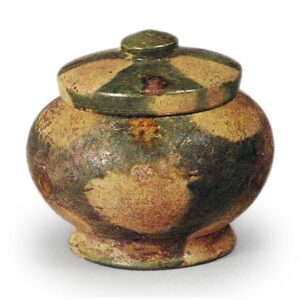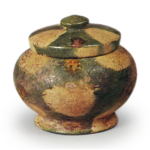
Excavated from Ohtobishima, Kasaoka City, Okayama Prefecture
8th century
(Lid) Height 1.6cm, Diameter 4.2cm (Body) Height 4.1cm, Mouth diameter 3.4cm, Body diameter 5.7cm
Kasaoka Municipal Museum of History
Sansai small vases have been found mainly at ritual sites dating from the Nara period, with the upper limit being a burial accessory from the tomb of Kojita Anmanko, which bears an inscription on a tomb tablet dated 729 (the sixth year of Jingi).
On Ohbishima Island, seven bodies and 13 lids were found together with Tang mirrors, 12 imperial coins, glassware, earthenware Sue ware: gray glazed pottery, and others. The body and body diameter are all 5 to 6 cm in height, and the technique used for the decoration is a simplified version of that used on large sancai jars. The body is divided into three sections, and three arcs are painted in green glaze at different levels, with yellow glaze placed over the contact points of the green glaze arcs at each level, which is common to all small three-color jars. The lid is also painted on three sides with green glaze centered on the knob, and yellow glaze is placed in the center of the green glaze on the periphery. One of the three-color jars was placed in a Sue ware jar at Ohbijima and placed in a votive state on a megalithic stone.








